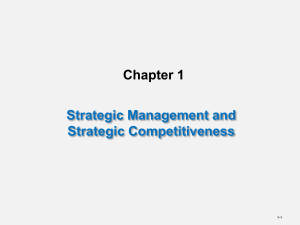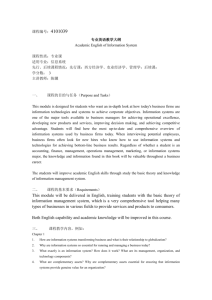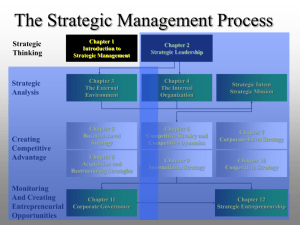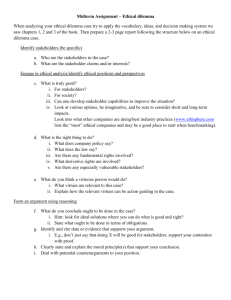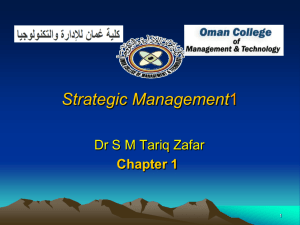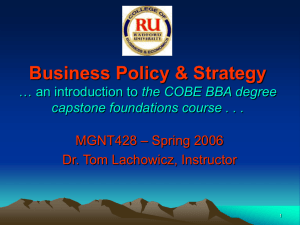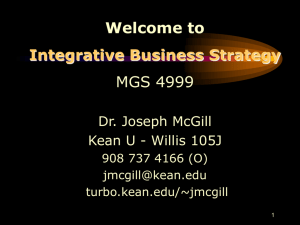Textbook slide
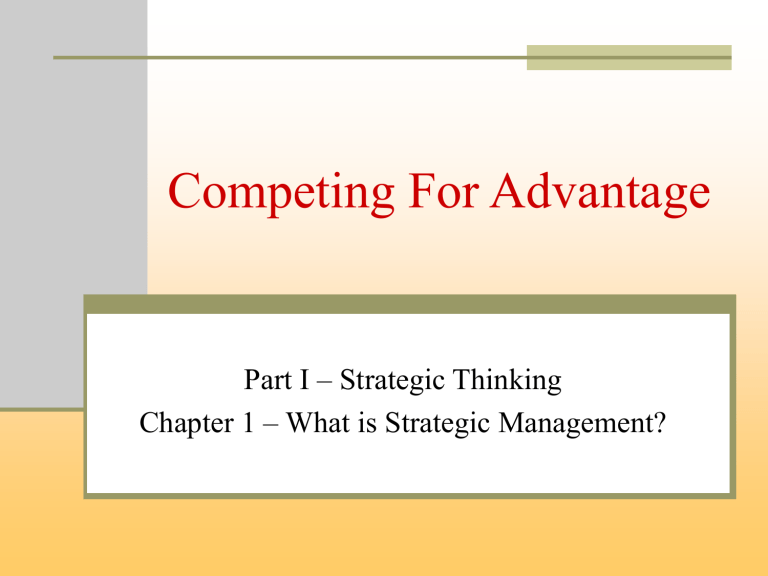
Competing For Advantage
Part I – Strategic Thinking
Chapter 1 – What is Strategic Management?
The Competitive Landscape
- An Illustration
U.S. Automobile Industry Conditions in 1970s
Increase in gas prices
Dramatic increase in quality of Japanesemade vehicles
Negative Impact to U.S. Automakers
Slow response to global forces
Inability to compete against new entrants to
US market
Failure to make technological improvements to stay competitive
Globalization of Markets and Industries
Key Terms
Globalization – increased economic interdependence among countries as reflected in the flow of goods and services, financial capital, and knowledge across country borders
Hypercompetition – extremely intense rivalry among competing firms, characterized by escalating and increasingly aggressive competitive moves
Globalization of Markets and Industries
Reduced restraints on business transactions across national boundaries (such as tariffs)
Difficulty in recognizing or determining boundaries of an industry (for example, the blur among television, telephone, and computer service providers)
Greatly increased range of opportunities for acquiring resources (such as equipment, capital, raw material, or even employees) and for selling goods and services
Globalization of Markets and Industries
Hypercompetition resulting from the dynamics of strategic maneuvering among global and innovative competitors
Increased performance standards in many areas, including quality, cost, productivity, product introduction time, and operational efficiency
Continuous improvement in all areas is necessary for continued survival
Technological Advances
Key Terms
Strategic Flexibility – set of capabilities used to respond to various demands and opportunities existing in a dynamic and uncertain competitive environment
Technological Trends
Increasing rate of technological change and diffusion, and increasing speed at which technologies become available and are used
Dramatic information technology changes of recent years, and different ways that information is being used
Increasing knowledge intensity, the basis for technology and its application
Changes in the Competitive Landscape
Changes in the Competitive Landscape
Quick competitive information needs
Shorter product life cycles
Indistinguishable products
Rapid technology replacement
Availability of inexpensive information
New business culture from electronicbusiness models
Continuous learning is necessary
Sources of Competitive Advantage
Speed to market
Access and use of information
Rapid diffusion of new, transformed knowledge throughout the company
Innovation
Integration of new conditions into organization mind set
Global standard achievement
Strategic flexibility
Disruptive Technologies
Value of existing technologies is destroyed
Creative destruction process replaces existing technologies with new ones
New markets are created
Early Influences on the Strategy Concept
Key Terms
Agency Theory – the idea that agency problems exist when managers take actions that are in their own best interests rather than those of shareholders
Transactions Costs Economics – examination of the efficiency of economic activity that instructs firms to buy required resources through a market transaction, unless certain conditions exist that efficiently allow firms to create them internally
Foundational Concepts
The need to establish goals, formulate strategies to achieve them, and set implementation (resourceallocation) plans to meet them
The integration of external market factors into business planning
The wisdom of balancing the conflicting needs of internal and external stakeholders
The importance of an economic approach to identifying market opportunities
The importance of having or acquiring the resources and capabilities to achieve organizational objectives
Foundational Concepts (cont.)
The idea that political strategies should be used in addition to rational-deductive strategy development to address stakeholder interests and facilitate the achievement of organizational goals
The use of organizational learning processes to achieve strategic success
The use of Agency Theory to focus on shareholder returns as a primary criterion for firm success
The use of Transactions Costs Economics to determine whether a business should produce or acquire the resources needed
Modern Strategic Management
Key Terms
Deterministic Perspective – the argument that a firm should adapt to its environment, establishing "fit“ (environmental situation determines the most effective strategies for achieving success)
Enactment – the principle that recognizes the potential of influencing the environment through human action (environmental forces do not entirely determine strategic moves to create a competitive advantage)
Three Perspectives on Value Creation
Industrial/Organization (I/O)
Economic Model
Resource-Based View
Stakeholder Approach
The Industrial/Organization (I/O)
Model of Above-Average Returns
Basic Premise of the I/O Model
– to explain the dominant influence of the external environment on a firm's strategic actions and performance
The Industrial/Organization (I/O)
Model of Above-Average Returns
Underlying Assumptions
That the external environment imposes pressures and constraints that determine the strategies resulting in above-average returns
That most firms competing within a particular industry or industry segment control similar strategically relevant resources and pursue similar strategies in light of those resources
The Industrial/Organization (I/O)
Model of Above-Average Returns
Underlying Assumptions (cont.)
That resources for implementing strategies are highly mobile across firms, and that due to this mobility any resource differences between firms will be short lived
That organizational decision makers are rational and committed to acting in the firm's best interests, as shown by their profitmaximizing behaviors
The
Industrial/
Organization
(I/O) Model of Above-
Average
Returns
The Industrial/Organization (I/O)
Model of Above-Average Returns
Michael Porter’s Five-Forces Model
Reinforces the importance of economic theory
Offers an analytical approach that was previously lacking in the field of strategy
Describes the forces that determine the nature/level of competition and profit potential in an industry
Suggests how an organization can use the analysis to establish a competitive advantage
The Industrial/Organization (I/O)
Model of Above-Average Returns
Limitations
Only two strategies are suggested:
Cost Leadership
Differentiation
Internal resources and capabilities are not considered
The Resource-Based Model of
Above-Average Returns
Key Terms
Distinctive Competencies – attributes that allow a firm to pursue a certain strategy more efficiently than other firms
Resources – inputs into a firm's production process, such as capital equipment, employee skills, patents, high-quality managers, financial condition, etc.
Capability – capacity for a set of resources to perform a task or activity in an integrative manner
The Resource-Based Model of
Above-Average Returns
Key Terms (cont.)
Core Competencies – a firm’s resources and capabilities that serve as sources of competitive advantage over its rivals
Competitive Advantage – the successful formulation and execution of strategies that are different from and produce more value than the strategies of competitors
Sustainable Competitive Advantage (referred to as "Competitive Advantage" in text) – competitive advantage that is possible only after competitors' efforts to duplicate the value-creating strategy have ceased or failed
The Resource-Based Model of
Above-Average Returns
Basic Premise of the Resource-
Based Model – to propose that a firm's unique resources and capabilities should define its strategic actions and be used effectively to exploit opportunities in the external environment to ensure successful performance
The Resource-Based Model of
Above-Average Returns
Three Categories of Resources
Physical
Human
Organizational capital
The Resource-Based Model of
Above-Average Returns
Types of resources that become a competitive advantage
Valuable
Rare
Costly to imitate
Nonsubstitutable
The Resource-Based Model of
Above-Average Returns
Two types of core competencies
Managerial competencies
Product-related competencies
The
Resource-
Based Model of Above-
Average
Returns
The Stakeholder Model of Responsible
Firm Behavior and Firm Performance
Key Terms
Stakeholders – individuals and groups that can affect (and are affected by) the strategic outcomes a firm achieves, and that have enforceable claims on a firm's performance
Strategic Intelligence – information that firms collect from their network of stakeholders and use to deal with diverse and cognitively complex competitive situations
The Stakeholder Model of Responsible
Firm Behavior and Firm Performance
Basic Premise of the Stakeholder
Model – to propose that a firm can effectively manage stakeholder relationships to create a competitive advantage and outperform its competitors
The Three Stakeholder Groups
Secondary Stakeholders
Government entities and administrators
Activists and advocacy groups
Religious organizations
Other nongovernmental organizations
The
Stakeholder
Model of
Responsible
Firm Behavior and Firm
Performance
Ways Stakeholder Relationships
Contribute to Competitive Advantage
Timely and high quality strategic intelligence is gathered to improve a firm's strategic decisions
A trustworthy reputation draws valuable customers, suppliers, and business partners to acquire or develop competitive resources
A trustworthy reputation attracts investors to offer financial resources
Firms that have fair and respectful treatment of employee relationships attract high-quality human resources
Ways Stakeholder Relationships
Contribute to Competitive Advantage
Transactions costs associated with making and enforcing agreements can be reduced
Implementation of strategies can be enhanced by improving commitment from stakeholders who are involved with strategic decisions
Responsible behavior can protect a firm from the expense and risk associated with negative actions (such as adverse regulations, legal suits and penalties, consumer dissatisfaction, employee work outages, or bad press)
Strategic Thinking and the Strategic
Management Process
Key Terms
Strategic Management Process – full set of commitments, decisions, and actions required for a firm to create value and earn returns that are higher than those of competitors
Strategic Thinking
Key Terms
Strategic Intent – organizational term used for a vision that challenges and energizes a company; the leveraging of a firm's resources, capabilities, and core competencies to accomplish a firm's goals in its competitive environment
Resources – inputs into a firm's production process, such as capital equipment, employee skills, patents, high-quality managers, financial condition, etc. (Described in Chapter 4)
Strategic Thinking
Key Terms
Capability – capacity for a set of resources to perform a task or activity in an integrative manner
Core Competencies – resources and capabilities that serve as a source of competitive advantage for a firm over its rivals
Effective Formation of Strategic Intent
When all levels of a firm are committed to the pursuit of specific, significant performance criterion
When employees believe fervently in their company's product
When employees are entirely focused on the firm's ability to outperform its competitors
Elements of Strategic Thinking
Takes advantage of unanticipated opportunities as they arise
Recognizes all time frames (learning from past experiences, exploiting current competitive advantages, and considering long-term implications of decisions and actions)
Is a sequential process of hypothesis testing (evaluating creative ideas from their generation, to trial market assessment, to full-blown market implementation)
Encouraging Strategic Thinking
Employ top managers who are champions of change
Put in place systems and processes to find innovative ideas for operating ("front line") areas of an organization
Train managers and employees in strategic thinking methods and processes
Provide flexibility in strategic management processes to allow incorporation of new ideas that have potential
The Strategic
Management
Process
Ethical Questions
What is the relationship between ethics and the firm’s stakeholders? For example, from an ethical perspective, how much information should the firm reveal to each of its stakeholders, and how should that vary among stakeholders?
Ethical Questions
Do firms face ethical challenges —perhaps even ethical dilemmas —when trying to satisfy both short-term and long-term expectations of capital market stakeholders?
Ethical Questions
What types of ethical issues and challenges do firms encounter when competing internationally?
Ethical Questions
What ethical responsibilities does the firm have when it earns above-average returns?
Who should make decisions regarding these issues, and why?
Ethical Questions
How should ethical considerations be included in analyses of the firm’s external environment and internal organization?
Ethical Questions
What should top-level managers do to ensure that a firm’s strategic management process leads to outcomes that are consistent with the firm’s values?
